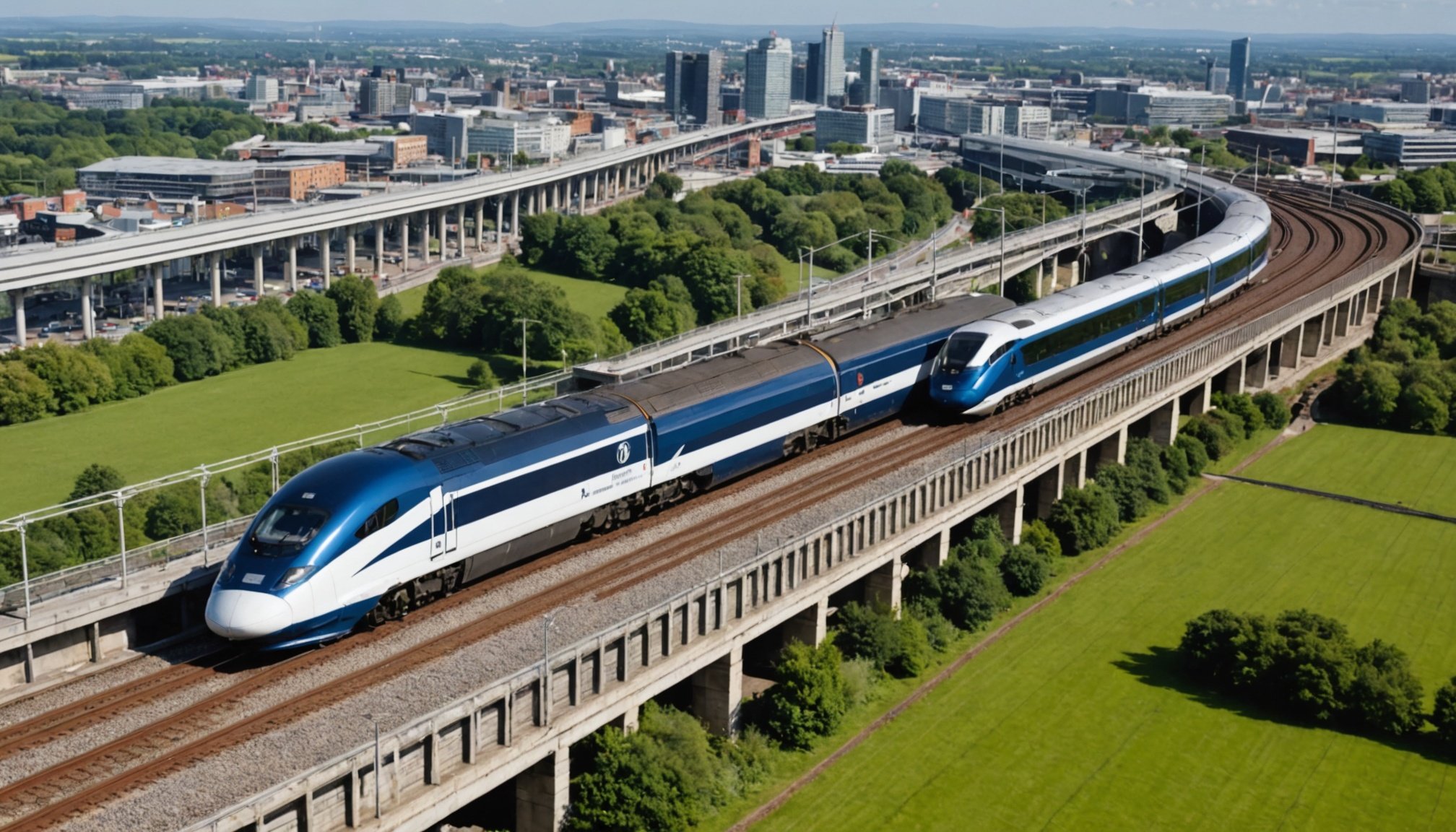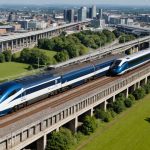Introduction to High-Speed Rail Developments in the UK
The high-speed rail landscape in the UK is undergoing notable changes, revolutionising the rail infrastructure. Several ambitious UK transportation projects aim to enhance the country’s connectivity and efficiency. Historically, the UK’s high-speed rail endeavours began with the completion of High-Speed 1 (HS1) linking London to the Channel Tunnel. This project set the stage for future developments by proving the feasibility and benefits of high-speed rail.
The ongoing High-Speed 2 (HS2) project is central to the current infrastructure evolution. This major initiative aims to connect London, Birmingham, Manchester, and Leeds, significantly reducing travel times. By increasing the network capacity, these enhancements promise substantial boosts in regional connectivity, benefiting both commuters and the economy.
Have you seen this : Selecting the Ideal Property Management Software for Managing Multi-Site Portfolios in the UK: Your Ultimate Guide
Looking ahead, further high-speed rail projects are anticipated to fortify the existing network. Such projects underscore the pivotal role of rail infrastructure in sustaining economic growth and addressing environmental concerns by reducing dependency on road transport. The future of high-speed rail in the UK appears promising, with its potential impacts extending beyond transportation, influencing housing, job creation, and regional development strategies.
Impact of High-Speed Rail on Property Values
High-speed rail systems have a profound influence on property values, stemming from enhanced accessibility and connectivity. Studies indicate an initial uptick in the real estate market near new stations. Properties close to these rail stations often experience increased demand due to the convenience offered by quicker commutes. For instance, some pretty specific case studies from the UK reveal upsurges in property values as soon as high-speed rail developments are announced.
Have you seen this : Mastering Property Portfolio Management Across Varied UK Locations: Expert Strategies for Success
Academic research demonstrates these value changes aren’t uniform. Factors such as proximity to rail stations, local economic conditions, and pre-existing transport connections play pivotal roles. Properties directly adjacent to rail lines might see a mixed effect, balancing improved transport links with potential noise and congestion concerns. Moreover, areas with robust prior infrastructural support might observe a less dramatic shift in values.
Analysing data from various UK locations offers rich insights. Property values in these regions can rise substantially, yet they also reflect local factors that either amplify or mitigate these positive effects. It’s crucial for potential investors to recognise these variations to better navigate the real estate market influenced by high-speed rail developments.
Statistical Analysis of Property Value Changes
Exploring how property values shift is a multifaceted endeavour that blends statistical analysis with real-world factors influencing the housing market.
Data Collection Methods
The research findings rely on accurate property value data. Data was compiled from national housing databases, government agencies, and local municipalities. These sources provided comprehensive insights into property trends. Rigorous methodologies were applied, utilising statistical analysis techniques such as regression analysis and time-series analysis. These methods ensured precision in understanding value shifts over varied locales.
Key Findings from the Analysis
The statistical analysis revealed a general increase in property values across urban centres. High-demand areas saw significant gains. However, some rural areas experienced stagnation or decline due to economic variables unrelated to housing. Such notable exceptions underscore the complexity of market dynamics.
Comparative Studies with Other Transportation Initiatives
Our analysis included a look at international high-speed rail projects. These ventures often coincide with significant property value upticks, similar to trends observed with other transit developments. Traditional rail systems showed moderate impacts, typically enhancing accessibility-driven value increases. Understanding these comparative outcomes provides a broader context for interpreting urban property dynamics.
Regional Variations in Property Value Effects
Within the dynamic landscape of the property market, regional analysis plays a crucial role in understanding localised effects on property values. Major cities often exhibit distinct patterns due to their vibrant local economies. In these urban centers, property market fluctuation is closely tied to infrastructure developments, including transportation enhancements like high-speed rail projects. Such developments can increase demand, pushing property values upwards.
Conversely, rural areas present unique challenges and opportunities. These regions may initially experience modest benefits from high-speed rail, potentially revitalizing stagnating markets. However, significant property value increases are not guaranteed and can vary widely based on demographic factors and economic growth prospects. Proximity to rail stations and the overall accessibility improvements largely dictate these shifts.
Demographic factors further influence value variations. Younger populations may drive housing demand in thriving areas, encouraging fast price growth, whereas aging populations might see slower market movement. Additionally, local economies with diverse industries often exhibit more resilience in property market fluctuation. Understanding these localized factors is essential for property investors and policymakers.
By considering these variations, stakeholders can make informed decisions on investments and developments, ensuring they reflect both regional needs and opportunities.
The Benefits and Drawbacks of High-Speed Rail Developments
Understanding the benefits of high-speed rail requires examining its socio-economic impacts on local communities. High-speed rail systems can significantly bolster local economies by creating jobs during construction and ongoing maintenance. New stations attract businesses, boosting the local economy and increasing property values. This connectivity enhances opportunities for employment and tourism, leading to broad regional economic growth.
However, it is crucial to also consider potential drawbacks. One significant concern is gentrification. As property values rise, original residents may face displacement, changing the community’s character. This socio-economic impact can create an imbalance, negating some economic benefits.
Additionally, while infrastructure investments bring necessary developments, they can often prioritize economic over social equity issues. This balance is critical—investments should be equitable, considering long-term impacts on all community members. Without careful planning, high-speed rail developments may inadvertently widen socio-economic divides, which raises questions about how to manage growth sustainably.
In essence, while there are tangible benefits of high-speed rail, addressing these potential drawbacks requires thoughtful strategies that integrate infrastructure development harmoniously with the socio-economic landscape of affected areas.
Practical Implications for Homeowners and Investors
Navigating the real estate investment landscape requires an understanding of market trends and strategic approaches, especially when dealing with properties near high-speed rail lines. For homeowners, evaluating the potential impacts of proximity to high-speed rail involves examining community accessibility and future property value growth. Before purchasing, homebuyers should consider buyer strategies, such as assessing noise levels and conducting comparative market analyses. Carefully analyzing market trends in these areas can help determine whether long-term investments will yield profitable returns.
For investors, properties adjacent to high-speed rail offer unique opportunities. As demand increases in these regions, real estate investment prospects often include potential for higher rental yields and property value appreciation. However, it’s vital to balance these opportunities with potential drawbacks, such as over-development risks or fluctuating demand based on infrastructure changes.
In the long term, both homeowners and investors must weigh the implications of property value retention. Factors influencing this include ongoing infrastructure investments, demographic shifts, and regional economic performance. Embracing strategic planning can secure effective homebuyer strategies, ensuring both short-term satisfaction and long-term financial gain, thereby positioning stakeholders to benefit from evolving market trends.
Expert Opinions and Future Projections
In the ever-evolving realm of real estate, expert insights provide invaluable guidance. Real estate analysts and economists continuously examine patterns to inform us of potential future developments. They agree that high-speed rail projects could transform the landscape significantly. By connecting urban and rural zones more efficiently, such infrastructures might lead to substantial growth in property demand, thereby affecting real estate forecasts.
While experts offer a range of perspectives, there is consensus that strategic urban planning is crucial. High-speed rail can alleviate congestion in densely populated areas, and its expansion may prompt policies that incentivise sustainable growth. Economists suggest that future trends will involve more integrated communities, where residential and commercial spaces coexist harmoniously.
As policymakers anticipate these future trends, they must consider the implications for urban planning. Improved connectivity can drive economic activities and housing developments away from traditional urban centres, promoting regional balance. Real estate forecasts indicate that areas previously deemed remote could become new hotspots for investment. Ultimately, the fusion of comprehensive urban policies with innovative transport solutions can create thriving, sustainable environments.











